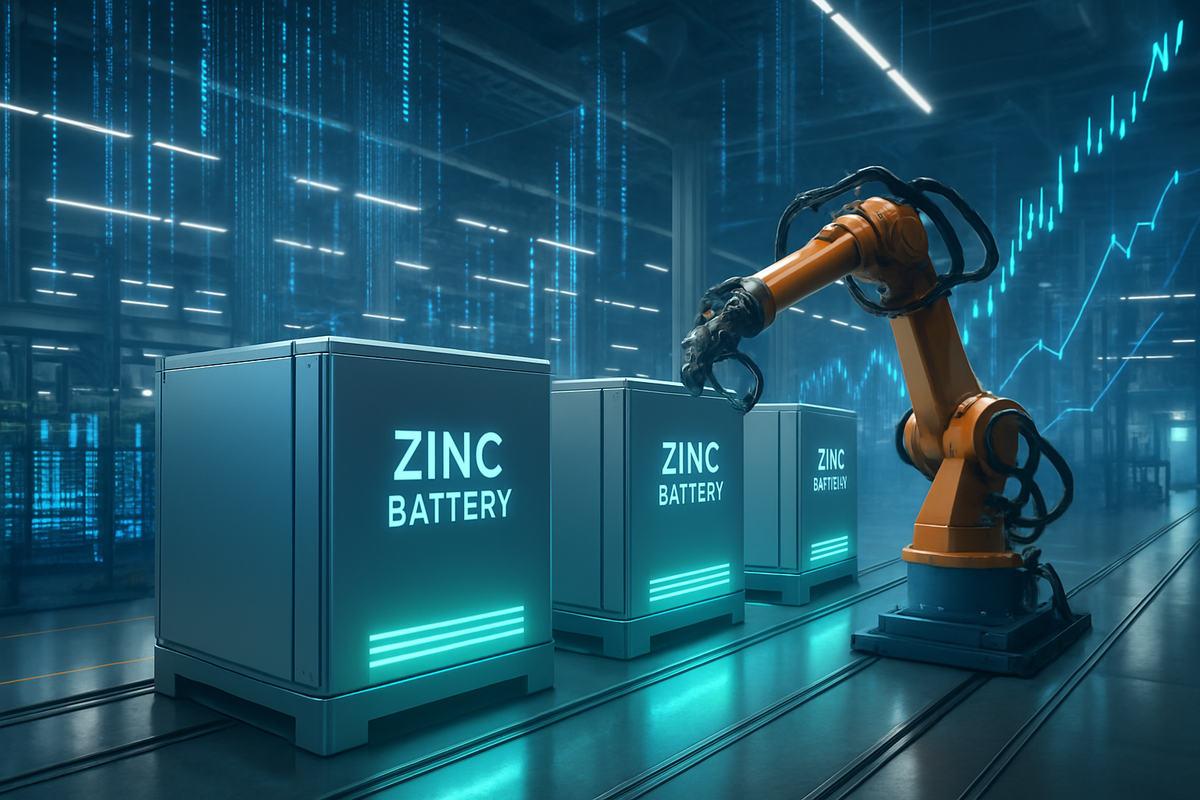
Eos Energy Enterprises (NASDAQ: EOSE), a leading manufacturer of zinc-based long-duration energy storage systems, is currently experiencing a wave of bullish sentiment, with many analysts and market observers anticipating a substantial rise in its stock price. As of October 2025, the company's prospects are significantly bolstered by a confluence of factors, including securing major supply agreements, a strategic expansion of its manufacturing footprint, and the burgeoning demand for reliable energy solutions from the rapidly expanding artificial intelligence (AI) and data center industries. This positive outlook signals a potentially transformative period for Eos, positioning it as a key player in the evolving energy landscape.
The immediate implications of this optimistic forecast are already evident in EOSE's robust stock performance, which has seen significant gains year-to-date. Investor confidence appears to be at an all-time high, driven by the company's proactive measures to scale production and its innovative, non-flammable zinc-based battery technology. While the company still navigates the path to profitability, its strategic moves and the increasing market need for long-duration energy storage are painting a promising picture for its future valuation.
Detailed Coverage of the Event
Eos Energy's positive trajectory is underpinned by several critical developments. The company recently solidified its market position through a landmark supply agreement with MN8 Energy, one-of the largest independent renewable energy companies in the U.S. This deal entails providing up to 750 MWh of Eos's advanced Z3™ energy storage systems, with an initial phase targeting 200 MWh to integrate solar generation with long-duration storage. Furthermore, a strategic partnership with Talen Energy (NYSE: TLN) aims to develop gigawatt-hour (GWh)-scale energy storage capacity across Pennsylvania, specifically to address the escalating power demands of AI infrastructure, utilizing Eos's American-made Z3 zinc batteries. These agreements underscore the growing trust in Eos's technology and its ability to meet large-scale energy demands.
A cornerstone of Eos's growth strategy is its ambitious manufacturing expansion and strategic relocation. The company is investing a substantial $352.9 million to move its headquarters from New Jersey to Pittsburgh and significantly expand its manufacturing operations in Allegheny County, Pennsylvania. This initiative, dubbed "Project AMAZE," involves a new 432,000-square-foot facility in Marshall, poised to nearly double production capacity to an annualized rate of 2 GWh by the fourth quarter of 2025. This expansion is projected to create 735 new jobs and retain 265 existing positions, bolstered by a $22 million investment from the Commonwealth of Pennsylvania, highlighting a strong commitment to domestic manufacturing and job creation.
The surging demand from the AI and data center sectors is a primary catalyst for Eos's anticipated growth. These energy-intensive operations require stable, long-duration power solutions, a niche perfectly suited for Eos's zinc-based technology. This demand, combined with the company's technological advancements like the integration of next-generation DC-to-DC power converters via a partnership with Unico and the launch of its proprietary battery management system, DawnOS, positions Eos at the forefront of addressing critical energy infrastructure needs. The company's Q2 2025 financial results further reinforce this positive momentum, with record quarterly revenue of $15.2 million, a 46% increase quarter-over-quarter, and a robust commercial opportunity pipeline reaching $18.8 billion, with an orders backlog of $672.5 million.
Initial market reactions have been overwhelmingly positive, with EOSE shares climbing over 8% on October 21, 2025, and boasting a remarkable year-to-date return of 249% by October 15, 2025. This strong performance reflects robust investor confidence, further supported by several Wall Street analysts issuing "Buy" ratings and increasing price targets. For instance, Guggenheim maintained a "Buy" rating on October 22, 2025, raising its price target from $10.00 to $20.00, while Stifel reiterated a "Buy" rating on October 15, 2025, increasing its target from $10.00 to $22.00, citing expected manufacturing progress and rising demand from AI data centers.
Companies That Might Win or Lose
The ascendance of Eos Energy Enterprises (NASDAQ: EOSE) and the escalating demand for long-duration energy storage (LDES), particularly from the energy-hungry AI and data center sectors, are creating a seismic shift across the energy landscape, creating both significant opportunities and formidable challenges for various public companies. Eos, with its innovative zinc-based Znyth batteries, is carving out a substantial niche in the non-lithium LDES market, offering a safe, scalable, and domestically sourced alternative that is gaining traction for grid-scale and industrial applications.
Unsurprisingly, Eos Energy itself stands as the primary beneficiary. Its market position has been significantly bolstered, with its stock experiencing remarkable surges, including a 249% year-to-date return as of October 2025, reflecting robust investor confidence. The company's strategic focus on scaling manufacturing, evidenced by its "Project AMAZE" expansion and a $277 million Department of Energy loan, along with key partnerships like the MN8 Energy supply agreement and the Talen Energy (NYSE: TLN) collaboration, positions it for continued growth. Beyond Eos, other LDES innovators specializing in non-lithium chemistries are also poised to benefit. Companies such as ESS Tech Inc. (NYSE: GWH), known for its iron flow batteries, Invinity Energy Systems (AIM: IES; OTC: IESVF) with its vanadium flow batteries, and Redflow Ltd (ASX: RFX) focusing on zinc-bromine flow batteries, are likely to see accelerated commercialization and increased investment as the market diversifies beyond lithium-ion for multi-hour applications.
The ripple effect extends to raw material suppliers for zinc batteries, though many key players like Grillo-Werke AG and EverZinc are private. However, the increased demand for high-purity zinc will likely benefit publicly traded zinc mining and refining companies indirectly. Furthermore, balance of plant (BOP) and system integrators like Fluence Energy (NASDAQ: FLNC), a pure-play grid-scale energy storage technology and services provider, are set to win as they provide the crucial supporting infrastructure, power electronics, and software (like its AI-powered Mosaic and Nispera platforms) required for large-scale battery energy storage systems (BESS). Hyperscale data center operators and AI companies, including giants like Microsoft (NASDAQ: MSFT), Amazon (NASDAQ: AMZN) (AWS), Alphabet (NASDAQ: GOOGL) (Google Cloud), and Meta (NASDAQ: META), are also indirect winners. As massive electricity consumers, their need for reliable, low-carbon power makes them significant customers for LDES providers, driving investments in energy storage to meet sustainability goals and ensure uninterrupted service.
Conversely, some companies may face increased competitive pressure. Lithium-ion battery manufacturers that are heavily focused on long-duration grid applications, despite their dominance in short-duration storage and electric vehicles, could see their market share eroded in specific multi-hour segments. While companies like Tesla (NASDAQ: TSLA) with its Megapack systems, BYD (HKEX: 1211; OTC: BYDDY), and CATL (SZSE: 300750; OTC: CTATF) remain formidable, the growth of non-lithium LDES alternatives offers advantages in cost, safety, and lifespan for certain applications, potentially necessitating strategic diversification or partnerships. Additionally, natural gas peaker plant operators and developers may experience a decline in demand for new constructions and lower utilization rates for existing plants. LDES systems effectively provide peak shaving, load shifting, and backup power—functions traditionally served by these fossil fuel-based assets—posing a challenge to the profitability of independent power producers (IPPs) and utility companies heavily reliant on gas-fired generation as the grid decarbonizes.
Wider Significance
The rapid growth of Eos Energy Enterprises (NASDAQ: EOSE) and the surging demand for long-duration energy storage (LDES), particularly from the burgeoning AI and data center sectors, signify a profound and irreversible shift in the global energy landscape. This transformation is not merely about new technologies but about fundamentally reshaping how power grids operate, how renewable energy is integrated, and how critical digital infrastructure is sustained in an increasingly electrified and digitized world. Eos's success underscores the growing maturity and investment in non-lithium-ion LDES technologies, validating alternatives like zinc-based batteries as safe, sustainable, and domestically sourced solutions for multi-hour discharge applications.
This trend is deeply embedded within broader industry movements. Firstly, it's a critical enabler of accelerated renewable energy integration. As solar and wind power continue their rapid expansion, LDES becomes indispensable for balancing their intermittency, ensuring a stable and reliable power supply around the clock. Secondly, it's a cornerstone of grid modernization and resilience, offering flexibility, dispatchable capacity, and enhanced protection against disruptions and extreme weather events. Thirdly, Eos's commitment to U.S.-based manufacturing, with nearly 100% domestic sourcing of its Z3 battery materials, aligns perfectly with national goals for energy independence and supply chain resilience, reducing reliance on volatile global markets and critical raw materials.
The ripple effects of this LDES surge are far-reaching. Economically, significant investment in LDES technologies and manufacturing facilities, like Eos's "Project AMAZE" expansion, promises to create thousands of new jobs in R&D, manufacturing, installation, and maintenance, fostering robust regional economic development. Environmentally, widespread LDES deployment will facilitate deeper decarbonization of power systems, leading to substantial reductions in greenhouse gas emissions and hazardous air pollution by enabling greater renewable integration. Technologically, increased demand and investment will inevitably accelerate innovation in LDES, driving down costs and improving performance, mirroring the trajectory seen with solar PV and lithium-ion batteries over the past decades. Furthermore, LDES supports the decentralization of energy systems, empowering microgrids and off-grid solutions, enhancing energy independence and resilience for a variety of applications.
However, the full potential of LDES cannot be realized without supportive regulatory and policy frameworks. Current regulations often present barriers, highlighting the need for clear definitions, classifications, and rules for LDES to ensure it is appropriately valued and compensated for its diverse grid services. Targeted incentives and funding, akin to the U.S. Inflation Reduction Act's provisions, are crucial for de-risking investments and fostering market growth. Streamlined permitting and interconnection processes are also essential to avoid delays in deployment. Historically, government support and incentives have been pivotal in accelerating nascent energy technologies, as seen with the rapid scaling of solar photovoltaics and lithium-ion batteries. The trajectory of lithium-ion batteries, moving from niche applications to gigawatts of annual capacity in less than a decade due to declining costs, technological advances, and economies of scale, provides a powerful precedent for how LDES technologies can achieve similar rapid scale-up and grid integration with the right policy environment.
What Comes Next
The future for Eos Energy Enterprises (NASDAQ: EOSE) and the broader long-duration energy storage (LDES) market is poised for dynamic and transformative growth, characterized by strategic expansion, technological maturation, and an escalating global demand for resilient and decarbonized power. As of October 2025, Eos is executing an aggressive strategy to capitalize on this burgeoning market.
In the short term (late 2025 - 2026), Eos is focused on operationalizing its "Project AMAZE" manufacturing expansion in Pennsylvania, which includes a new 432,000 sq. ft. facility aimed at significantly boosting its annualized energy storage capacity towards 8 GWh. This expansion, supported by a $24 million state-led economic development package, is critical for meeting its substantial order backlog and converting its growing commercial pipeline into revenue. Concurrently, the establishment of a new software hub in Pittsburgh, dedicated to its proprietary DawnOS™ battery management system and backed by collaborations with Carnegie Mellon University, signals a strategic emphasis on software and analytics to optimize its storage solutions. Key partnerships, such as the multi-gigawatt collaboration with Talen Energy (NYSE: TLN) to support AI infrastructure and the MN8 Energy supply agreement for up to 750 MWh, are expected to rapidly accelerate project deployments and market penetration. The company's reaffirmed 2025 revenue outlook of $150 million to $190 million, coupled with strong Q2 2025 results and bolstered financial flexibility from recent offerings and a DOE loan, paints a picture of robust short-term execution.
Looking further ahead (beyond 2026), Eos aims to solidify its position as a leading innovator in American-made zinc-based LDES, offering a viable, safe, and sustainable alternative to lithium-ion for critical mid- to long-duration applications. Continued scaling through automation and increased capacity is expected to drive down costs and enhance the efficiency of its Znyth™ technology. The company's strategic focus on addressing the energy demands of AI and data centers, coupled with its domestic manufacturing emphasis, positions it strongly within national energy security and decarbonization agendas. Potential strategic pivots could include a more aggressive expansion of its software-as-a-service (SaaS) offerings, leveraging DawnOS beyond its own systems, or even a very long-term consideration of diversifying into other non-lithium LDES chemistries to broaden its market reach, although its current focus remains firmly on zinc.
The broader LDES market presents immense opportunities. Driven by global decarbonization goals, the intermittency of rapidly expanding renewable energy sources, and critical government incentives (such as the U.S. Inflation Reduction Act and specific DOE funding), the market is projected to experience explosive growth, with some forecasts predicting an 80% compound annual growth rate (CAGR) from 2024 to 2030. LDES is becoming indispensable for grid stability, resilience, and enabling deep decarbonization. However, challenges persist, including high upfront capital costs, the ongoing maturation of diverse LDES technologies, potential supply chain constraints, and the need for evolving regulatory frameworks that adequately value long-duration services. While short-duration lithium-ion batteries currently dominate, the increasing capabilities of lithium-ion extending to 6-8 hours also present a competitive dynamic within the LDES space.
Comprehensive Wrap-up
As of October 2025, Eos Energy Enterprises (NASDAQ: EOSE) stands at a pivotal juncture, poised for significant growth and potential stock appreciation. The company's strategic investments in U.S. manufacturing through "Project AMAZE," coupled with landmark partnerships with entities like MN8 Energy and Talen Energy (NYSE: TLN), underscore its commitment to scaling its zinc-based Z3™ energy storage systems. This robust positioning is further amplified by the burgeoning demand for long-duration energy storage from the rapidly expanding AI and data center industries, creating a highly favorable market environment.
Moving forward, the market for LDES is expected to experience exponential growth, driven by global decarbonization efforts, the imperative for grid stability with increasing renewable integration, and supportive policy frameworks like the U.S. Inflation Reduction Act. Eos's "Made in America" strategy positions it uniquely to capitalize on these incentives, fostering energy independence and creating domestic jobs. While the company still navigates the path to consistent profitability and faces challenges such as high upfront capital costs and competition from other LDES technologies, its strong commercial pipeline, technological advancements, and positive analyst sentiment paint a compelling picture for its future.
The lasting impact of Eos's trajectory and the broader embrace of diverse LDES chemistries will be a more resilient, sustainable, and decentralized global energy system. This shift mitigates geopolitical risks associated with critical mineral sourcing and provides safer, more environmentally friendly alternatives to traditional storage. Investors should closely watch the execution of Eos's manufacturing expansion, its progress towards profitability, the conversion of its substantial order backlog into revenue, and the success of its key partnerships. Furthermore, monitoring the evolving competitive landscape and continued regulatory support will be crucial indicators of Eos's sustained success in the coming months and years.
This content is intended for informational purposes only and is not financial advice




